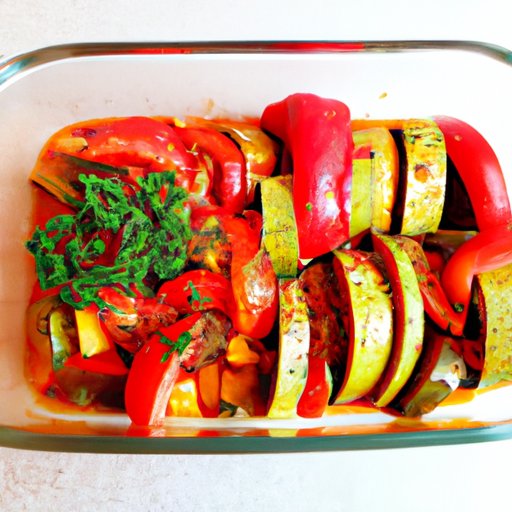Introduction
Ratatouille is a classic French dish that can seem daunting to cook for the first time. However, with the right ingredients and a few tips and tricks, anyone can make a delicious ratatouille. This article will provide a step-by-step guide to traditional ratatouille and explore variations of the dish to add a creative spin. We will also provide tips for using leftover ratatouille, making a vegan version, preparing a large batch for meal prep, and delve into the history and cultural significance of the dish.
A Step-by-Step Guide to Making Classic Ratatouille
Ratatouille is a vegetable stew that originated in the Provence region of France. The ingredients typically include tomatoes, eggplant, zucchini, onions, peppers, and garlic. This classic dish can be served as a side dish or as a main course with crusty bread or rice.
The following is a list of ingredients and equipment needed to make ratatouille:
- 1 onion, chopped
- 4 garlic cloves, minced
- 1 large eggplant, diced
- 2 zucchini, diced
- 1 red bell pepper, chopped
- 1 yellow pepper, chopped
- 4 large tomatoes, chopped
- 1/4 cup olive oil
- 1 teaspoon dried thyme
- Salt and pepper to taste
- Fresh parsley and basil for garnish
- Large pan with a lid
Here is a step-by-step guide to making classic ratatouille:
- Heat the olive oil in a large pan over medium heat.
- Add the onion and garlic and sauté until translucent, about 5 minutes.
- Add the eggplant and zucchini and cook for 10 minutes until they start to soften.
- Add the peppers and sauté for an additional 5 minutes.
- Add the tomatoes and thyme and season with salt and pepper. Stir to combine.
- Lower the heat, cover the pan, and let simmer for 20 to 30 minutes.
- Check the seasoning and adjust as needed.
- Garnish with parsley and basil and serve hot or at room temperature, with crusty bread or rice.
Some tips for making a successful ratatouille:
– Make sure to cut the vegetables into the same size so that they cook evenly.
– You can use either canned or fresh tomatoes, but fresh tomatoes are preferable.
– Let the ratatouille simmer with the lid on so that the vegetables release their juices and the flavors meld together.
– Allow the ratatouille to cool slightly before serving, as the flavors will become more pronounced.
5 Variations of Ratatouille to Try at Home
Ratatouille is a versatile dish that can be the base for endless flavor combinations. Here are five variations to try:
1. Ratatouille Niçoise: add anchovies and black olives for a salty twist.
2. Spiced Ratatouille: add cumin, paprika, and coriander for a Moroccan flavor.
3. Ratatouille with Fresh Herbs: add parsley, thyme, and rosemary for a fragrant herb boost.
4. Indian Ratatouille: add curry powder, garam masala, and coconut milk for an Indian flare.
5. Ratatouille with Goat Cheese: add crumbled goat cheese and broil for a melted topping.
Creative and Tasty Ways to Use Leftover Ratatouille
Ratatouille is a versatile ingredient that can be used in many ways. Here are a few ideas:
– Wraps: Stuff a wrap with leftover ratatouille, hummus, and avocado for a quick lunch on-the-go.
– Pasta: Cook your favorite pasta and add a scoop of ratatouille for a simple, filling dinner.
– Pizza: Use ratatouille as a pizza topping with mozzarella cheese and fresh herbs.
– Frittata: Beat eggs and add ratatouille for a tasty frittata.
– Sandwiches: Spread some ratatouille in your favorite sandwich for a quick, delicious lunch.
A Vegan Take on Ratatouille
Ratatouille can be easily made into a vegan dish. Here is a recipe for vegan ratatouille:
- 1 onion, chopped
- 4 garlic cloves, minced
- 1 large eggplant, diced
- 2 zucchini, diced
- 1 red bell pepper, chopped
- 1 yellow pepper, chopped
- 4 large tomatoes, chopped
- 1/4 cup olive oil
- 1 teaspoon dried thyme
- Salt and pepper to taste
- Fresh parsley and basil for garnish
- 1/2 cup nutritional yeast for topping (optional)
Instructions:
Follow the same instructions as for classic ratatouille, but omit the cheese topping and use nutritional yeast instead.
Tips for Making a Large Batch of Ratatouille for Meal Prep
Ratatouille can be a great option for meal prep and batch cooking, as it can be easily reheated and used in many dishes. Here are some tips for making a larger batch:
– Double or triple the ingredients as needed.
– Use a slow cooker or a pressure cooker for a larger volume.
– Freeze in individual portions for easy reheating.
– Serve with different sides or as a filling for different dishes.
The History and Cultural Significance of Ratatouille
Ratatouille originated in the Provence region of France, where farmers would gather the vegetables from their gardens to make a flavorful stew. The name comes from the verb “touiller,” which means “to stir” in French. The dish has evolved over time and has been adopted in other cultures, including Italy (where it’s called caponata), Spain (pisto), and North Africa (tajine). In the United States, it was popularized by the Disney movie “Ratatouille” in 2007.
Conclusion
Now that you have a step-by-step guide to making classic ratatouille, variations to try, ideas for using leftover ratatouille, and tips for meal prep and vegan options, you can confidently make this classic dish on your own. Ratatouille is a versatile, delicious, and healthy dish that can be customized to suit your preferences and creativity.
